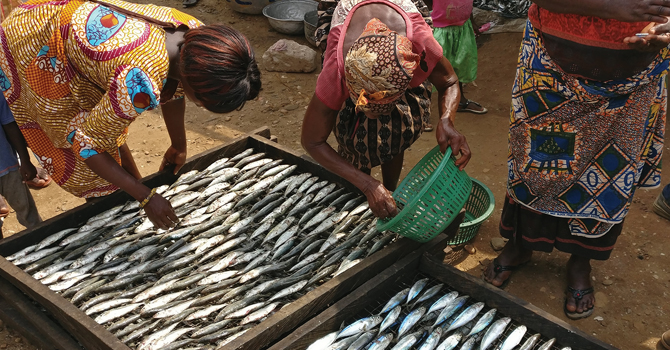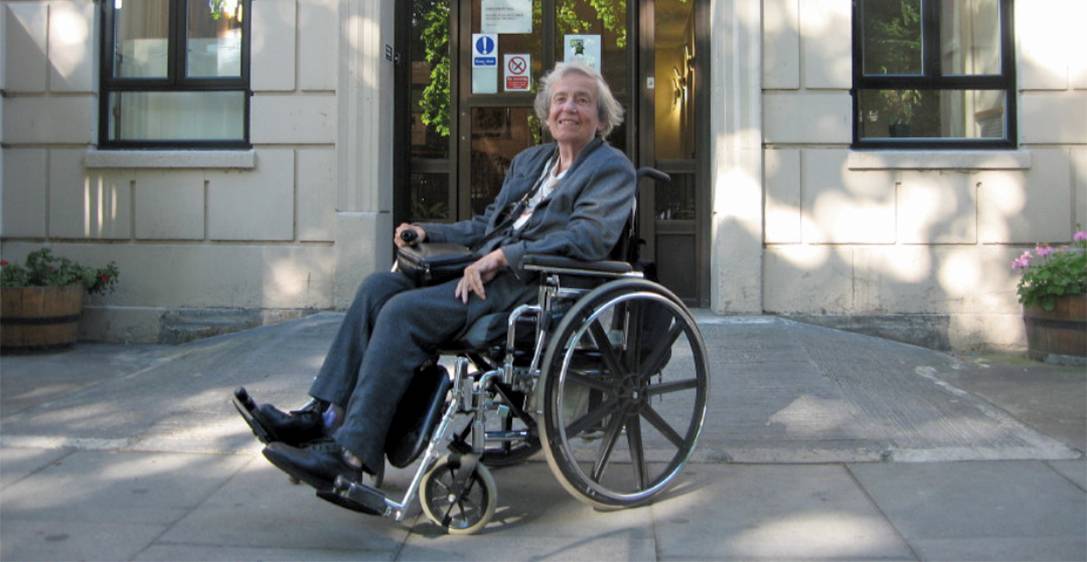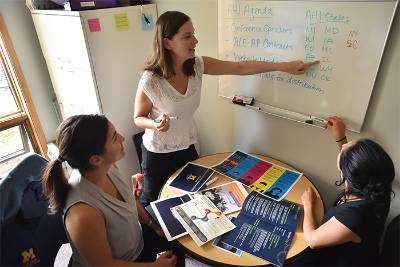Empowering Populations

The Imperfect Solutions That Magnify the Strengths of Vulnerable Populations and Improve the Health of Marginalized Communities
Watching her mother navigate life with multiple sclerosis taught Philippa Clarke the challenging and often invisible nature of the barriers faced by those living with disabilities. "From city streets to healthcare policies, our world is designed without them in mind," says Clarke, a professor of Epidemiology at Michigan Public Health.

Her mother's battle was fought on two fronts: a progressive disease in her body and the rapidly changing environments around her. She triumphed over both. "My mother became increasingly impaired, becoming unable to walk and finding herself in a wheelchair," Clarke says. "But she tried to find a way to negotiate each new impairment so that she never considered herself disabled. She moved to a bungalow once she could no longer climb stairs. When her wheelchair wouldn't fit through certain doorways, she would use an office chair to roll around the house."
Clarke's reflections on her mother's journey allude to the effective but imperfect solutions even the best interventions provide. And they remind us of the hidden strengths of individuals and communities that struggle and yet succeed. In many cases, the struggle to achieve health is not inherent to a community but is related to the world others have constructed around that community. As Clarke says, "Maybe the problem isn't a person's health but our deficient systems. Is my accessibility challenge because my legs are weak or because my steps were designed poorly?"
For many researchers at Michigan Public Health, traditional language around problem solving is giving way to ideas of accompanying, empowering, advocating, and even redesigning the world we live in.
Not Underserved but Vulnerable
When Andrew Jones considers the communities in which he does research, he never uses the word underserved. "Underserved kind of implies personal failure," says Jones, John G. Searle Assistant Professor of Nutritional Sciences. "It takes the agency away from the individual and the community. The people I work with in low-income communities are extremely capable. But they often don't have the resources they need to make full use of their skills and capabilities."
Jones does the bulk of his research in low- and middle-income countries, particularly in West Africa and the Andean regions of South America, mapping the ways changing food systems influence the health status of populations. Hamstrung by poverty, these populations in West Africa and the Andean regions of South America are acutely affected by low income and pulled into multigenerational patterns of interconnected deficiencies. Some of those deficiencies are, as Jones puts it, "inconspicuous," leading to stunted growth that can be all but invisible until adolescence. Others are more palpable. "Income controls so much," he says, "from access to health services to having a political voice."
"Food systems are unique in that we can intervene to improve nutrition and health
through multiple different pathways."
—Andrew Jones
Still, the most immediate impact of low income is access to healthy food. The paradoxical co-occurrence of obesity and under-nutrition in these communities, Jones says, makes them "not underserved but vulnerable." Poor nutrition early in life has "major consequences for health. Poorer brain development, increased susceptibility to infection, increased vulnerability to chronic disease—it all links back to unhealthy diets. And it affects one's ability to earn a decent income, which keeps the cycle going."
Jones and his collaborators address these complex nutritional problems through the food systems that underlie them. In Ghana, for example, his team works with a mobile phone startup, disseminating voice messages that provide information to women about how to prevent health problems like anemia, as well as market price information to help women entrepreneurs involved in fish smoking make better business decisions. Jones and his team also work to improve smoke-oven technology for these women to create more healthful working conditions and increase their earning power. "Food systems are unique in that we can intervene to improve nutrition and health through multiple different pathways," Jones says.
Stacking Opportunities to Address Inequities
Having a roof over your head is much like basic nutrition—without it, health outcomes can be negatively affected for generations. Roshanak Mehdipanah, assistant professor of Health Behavior and Health Education, works at the intersection of housing and sociopolitical determinants of health.
Her projects tackle complex issues like rent-to-own programs, gentrification, and how housing discrimination denies people life opportunities, such as stable employment, that can lead to better health outcomes. "We look at housing as wealth because that's what's transferred through families. You are denying or undercutting the opportunities to build that wealth when discriminating against a certain group based on their race, sex, disability status, national origin and familial status—to name a few," Mehdipanah says.
Like Jones, Mehdipanah abandons the term "underserved" in discussing her research, instead focusing on the ways inequities stack up for individuals. "The people I work with have been treated unequally, unjustly, and unfairly. They have been exposed to inequities because the systems around them are set up in ways that diminish their opportunities," she says. "We try to prevent those inequities from stacking, from multiplying themselves into additional disadvantages."
Mehdipanah is a faculty expert with the University of Michigan's Poverty Solutions, a presidential initiative that uses the university's interdisciplinary intellectual assets to test and implement innovative solutions for the prevention and alleviation of poverty. "These interdisciplinary research approaches, like Poverty Solutions and also Michigan Public Health's growing relationship with the College of Architecture and Urban Planning, are necessary to address with nuance and knowledge these issues around housing, poverty, and health inequity," she says.
Mehdipanah says she is grateful to be at a university that supports and promotes interdisciplinary work. "A large network of scholars collaborating on a single issue not only improves research outcomes but moves us much more quickly toward translating our insights into government resources and real policy improvements," she says. "When you're sitting at the table with people working directly on a housing initiative in a particular community or on policy that affects that initiative, we are that much closer to ensuring our work will help that community."

Stories Are Data, and Data Is Advocacy
Paul Fleming and William Lopez want to sit at the same table. In fact, they refuse to separate public health work from politics. "We come to public health to improve lives and to see that those lives are improved equitably," says Lopez, clinical assistant professor of Health Behavior and Health Education. Can that be done in a politically neutral way? "I think that answer changes for different generations, but in our current climate, the answer is no," says Lopez.
"Ultimately, we're trying to improve peoples' health," echoes Fleming, assistant professor of Health Behavior and Health Education. "And we know that policies and institutions are fundamental to whether or not certain communities are healthy. The way institutions and policies change is through evidence and advocacy, which can reshape them to better serve marginalized communities."
In collaboration with Lopez, Fleming is working to redefine how community clinics and federally qualified health centers in Detroit help families access health and food resources in the face of immigration enforcement. "Not all Latino immigrant families lack citizenship status, but many are still presumed to be undocumented. This makes them second-class members of their own communities. Because of their ethnicity, they're marginalized within a white-dominant society, and they're shut out of opportunities and health resources many of us take for granted. It forces many of them into poverty, to the margins of society."
Using PhotoVoice, a capacity-building advocacy tool for at-risk communities, Lopez and Fleming put the power of storytelling back into the hands of these communities so they can demonstrate with their own voices and photos how immigration enforcement harms them. The PhotoVoice method provides current, authentic data that lead to unusual angles in advocating for institutional change. "People in the immigrant community take photos of their daily life, and we get these rich stories and rich conversations that build off each other. Our role is to curate those stories and ensure they are shared with policymakers and clinics," says Fleming.
"These are marginalized folks whose stories aren't being told. Those stories are how we can help think through next steps, which interventions are most effective, and what clinics can do once they fully understand their community," says Fleming. "Traditional public health research might ask somebody what the barriers are to accessing care. But many people don't have time to think about barriers and access. They're just living their life."
A Community of Practice Meets a Community In Between
Growing up is difficult, but for millions of US adolescents seeking health care each year, aspects of the system might make it more difficult. Lauren Ranalli, MPH '06, has dedicated her career to improving care for underserved populations.

Adolescents are stuck in "a space in between, sandwiched in a health care system built for young children on one side and adults on the other," says Ranalli, director of the University of Michigan's Adolescent Health Initiative. "Without specific adolescent needs in mind, health systems too often miss the needs of teens and young adults."
Guided by a youth advisory council based in Washtenaw County, Ranalli and her team traverse the US helping state health departments, private clinics, and healthcare providers implement services that improve health center environments, policies, and practices and empower teens and young adults to take charge of their own health and health care. "It's not that health services don't exist. It's that teens are a tough group to engage in care," says Ranalli. "To ensure providers are engaging with their patients in a youth-friendly way and to get teens to continue coming back if they didn't have an experience that met their needs—that's a struggle."
Ultimately, Ranalli says, her team envisions a space "where adolescents can express their health care concerns and be empowered as healthcare advocates and consumers." They've created the Adolescent-Centered Environment Process (ACE-AP), a rigorous 18-month quality improvement program that provides tailored workflows, coaching, and training sessions for providers, and the Adolescent Champion Model, a broader initiative bringing together centers and providers on a state level—currently being implemented in five states—to build a "community of practice." Both models focus on meeting the diverse needs of underserved adolescents, including LGBTQ individuals, youth in urban, rural, and tribal communities, and other high-risk populations.
Wherever issues affecting adolescents are contentious, Ranalli returns to a fundamental aspect of public health: "There are going to be disputed topics, and there are going to be communities under attack. It's the work of public health professionals to use our resources and voices to elevate the cause of those who are most in need. Political and social disputes may ebb and flow, but the health concerns of populations don't go away."
Impaired but Adaptable and Not Yet Disabled
Philippa Clarke, whose mother's struggles with multiple sclerosis led her to a career in public health, sees disability quite literally as a matter of marginalization, where those with physical impairments are physically pushed to the edges of spaces and communities.
Clarke is opening the eyes of public health to the hidden world of impairment, one student at a time. "In a class I teach on social determinants of health, I send students out into public spaces with a scenario where they have a disability. They explore the barriers they experience, trying to get to a simple destination or complete a simple task like grocery shopping. It helps them understand the barriers we don't think about, what impairments mean and how they translate into disabilities," she says.
In the end, Clarke is hopeful for the next generation of public health researchers: "The American Public Health Association (APHA) now has a disability section, which is growing alongside the recognition of disability as a part of public health. Public health knows how to adapt to entirely new questions and will be a part of building new environments that account for the needs of the most vulnerable in our society."
Clarke and colleagues are accompanying those vulnerable individuals and communities on our way to designing a world that is more equitable and a good deal healthier for everyone in it.
